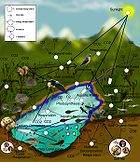- Malthusian growth model
-
The Malthusian growth model, sometimes called the simple exponential growth model, is essentially exponential growth based on a constant rate of compound interest. The model is named after the Reverend Thomas Malthus, who authored An Essay on the Principle of Population, one of the earliest and most influential books on population.
Contents
Formula
- P(t) = P0ert
where P0 = Initial Population, r = growth rate, sometimes also called Malthusian Parameter, t = time.
Exponential law
As noted by Peter Turchin (Does population ecology have general laws?, 2001 and Complex Population Dynamics, 2003), this model is often referred to as The Exponential Law and is widely regarded in the field of population ecology as the first principle of population dynamics,[citation needed] with Malthus as the founder.
At best, it can be described as an approximate physical law as it is generally acknowledged that nothing can grow at a constant rate indefinitely (Cassell's Laws Of Nature, James Trefil, 2002 - Refer 'exponential growth law'). Joel E. Cohen has stated that the simplicity of the model makes it useful for very short-term predictions and of not much use for predictions beyond 10 or 20 years (How Many People Can The Earth Support, 1995). Antony Flew - in his introduction to the Penguin Books publication of Malthus' essay (1st edition) - argued a "certain limited resemblance" between Malthus' law of population to laws of Newtonian mechanics.
Malthusian law
The exponential law is also sometimes referred to as The Malthusian Law (refer "Laws Of Population Ecology" by Dr. Paul Haemig, 2005).
Rule of 70
The rule of 70 is a useful rule of thumb that roughly explains the time periods involved in exponential growth at a constant rate. For example, if growth is measured annually then a 1% growth rate results in a doubling every 70 years. At 2% doubling occurs every 35 years.
The number 70 comes from the observation that the natural log of 2 is approximately 0.7, by multiplying this by 100 we obtain 70. To find the doubling time we divide the natural log of 2 by the growth rate. To find the time it takes to increase by a factor of 3 we would use the natural log of 3, approximately 1.1.
Logistic growth model
The Malthusian growth model is the direct ancestor of the logistic function. Pierre Francois Verhulst first published his logistic growth function in 1838 after he had read Malthus' An Essay on the Principle of Population. Benjamin Gompertz also published work developing the Malthusian growth model further.
See also
- Albert Bartlett - a leading proponent of the Malthusian Growth Model
- Exogenous growth model - related growth model from economics
- Exponential growth
- Growth theory - related ideas from economics
- Irruptive growth - an extension of the Malthusian model accounting for population explosions and crashes
- Population
- Mathematical models
- Neo-malthusianism
- Logistic function
- Scientific laws named after people - strictly speaking, no scientific law has been named after Malthus
- Scientific phenomena named after people - being mathematical, and relating to population dynamics, the Malthusian Growth Model qualifies
- Malthusian catastrophe
External links
- Malthusian Growth Model from Steve McKelvey, Department of Mathematics, Saint Olaf College, Northfield, Minnesota
- Logistic Model from Steve McKelvey, Department of Mathematics, Saint Olaf College, Northfield, Minnesota
- Laws Of Population Ecology Dr. Paul D. Haemig
- On principles, laws and theory of population ecology Professor of Entomology, Alan Berryman, Washington State University
- Mathematical Growth Models
- e the EXPONENTIAL - the Magic Number of GROWTH - Keith Tognetti, University of Wollongong, NSW, Australia
- Introduction to Social Macrodynamics Professor Andrey Korotayev
- Interesting Facts about Population Growth Mathematical Models from Jacobo Bulaevsky, Arcytech.
Topics on human population Major articles World population · Family planning · Green revolution · Overpopulation · Over-consumption (water crisis) · Reproductive rights · Sustainable developmentBiological topics Population biology · Population control (one-child policy · Immigration reduction) · Population decline · Population density (physiological density) · Population growth · Population pyramidPopulation ecology Carrying capacity · Ecological footprint · I = P • A • T · Malthusian growth model · World3 model · Food security · World energy consumption · World energy resources · Habitat destruction · Optimum populationLiterary works Lists Most highly populated countries · Metropolitan areas by populationEvents and
organizationsRelated articles World Population Day · "The Day of Five Billion" · "The Day of Six Billion" · "Day of Seven Billion" · "Ecological Debt Day" · Easter Island downfall · Classic Maya collapse · Holocene extinction · Fertility and intelligenceCategories:- Empirical laws
- Mathematical modeling
- Population
- Population ecology
- Demography
Wikimedia Foundation. 2010.


